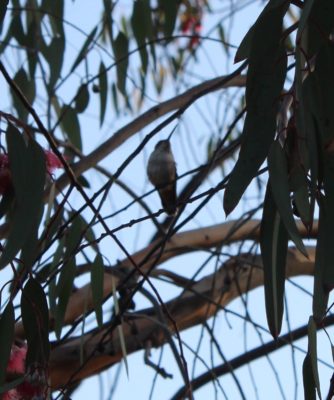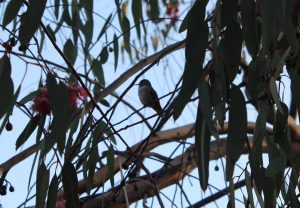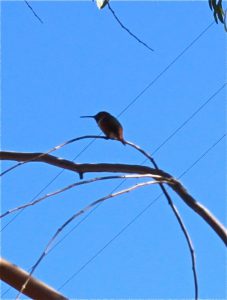
 Hummingbirds rank among some of the smallest bird species on Earth. They get their name from the sound their wings make as they rapidly beat them 50 times a second to keep their bodies aloft! Their wings rotate in a figure eight pattern, which allows the bird to hover or fly backwards if it needs to. Because they move so quickly, they also burn through energy quickly, so they constantly have to feed on nectar and insects throughout the day. At night they hibernate, slowing their ultrafast metabolisms down to a torporific state. During this time they also slow their heart rates from 1200 to 50 beats per minute.
Hummingbirds rank among some of the smallest bird species on Earth. They get their name from the sound their wings make as they rapidly beat them 50 times a second to keep their bodies aloft! Their wings rotate in a figure eight pattern, which allows the bird to hover or fly backwards if it needs to. Because they move so quickly, they also burn through energy quickly, so they constantly have to feed on nectar and insects throughout the day. At night they hibernate, slowing their ultrafast metabolisms down to a torporific state. During this time they also slow their heart rates from 1200 to 50 beats per minute.
 Catalina Island is home to three species of this tiny bird: the Anna’s Hummingbird, the migratory Allen’s Hummingbird, and the Channel Islands Allen’s Hummingbird. Male Allen’s Hummingbirds have bright, iridescent red-orange throats, and Anna’s Hummingbirds have magenta plumage on their throat and head. Both species can be found zooming around Catalina’s blossoming bushes and eucalyptus trees, feeding on nectar they find in the flowers. The Channel Islands Allen’s Hummingbird is endemic to all the Channel Islands except for Santa Barbara, and it is a permanent resident on Catalina. The migratory Allen’s Hummingbird winters in central Mexico and then works its way up the coast to spend its summers in California. Anna’s Hummingbirds can be found on Catalina all year round.
Catalina Island is home to three species of this tiny bird: the Anna’s Hummingbird, the migratory Allen’s Hummingbird, and the Channel Islands Allen’s Hummingbird. Male Allen’s Hummingbirds have bright, iridescent red-orange throats, and Anna’s Hummingbirds have magenta plumage on their throat and head. Both species can be found zooming around Catalina’s blossoming bushes and eucalyptus trees, feeding on nectar they find in the flowers. The Channel Islands Allen’s Hummingbird is endemic to all the Channel Islands except for Santa Barbara, and it is a permanent resident on Catalina. The migratory Allen’s Hummingbird winters in central Mexico and then works its way up the coast to spend its summers in California. Anna’s Hummingbirds can be found on Catalina all year round.
At 3 to 3.5 inches in length, these hummingbirds may be small, but don’t let that cause you to underestimate them! Male Allen’s Hummingbirds can be quite aggressive when they are defending their territory, and some have even been known to chase away red-tailed hawks! If you look at a tree buzzing with hummingbirds, you will soon notice several intense battles being waged, with the males sitting on conspicuous branches and quickly darting at anyone that tries to get near them. Male hummingbirds also put on a show when they mate, performing a courtship dance that includes a high-speed dive of 100 feet or more. With their dynamic flight patterns and brightly-colored bodies, these little hummingbirds are truly the feisty, speedy acrobats of the bird world.


